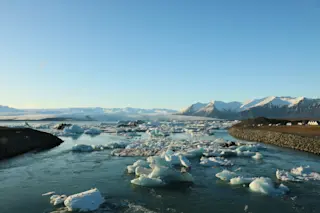A massive zone of cool water in the North Atlantic Ocean is slowing the melting of Iceland’s glaciers.
But the so-called Blue Blob, an anomaly in an otherwise warming ocean, may only be around for a few decades before the overall trend of warming takes over again, according to new research.
“Even though this Blue Blob seems to be good news for the glaciers, it’s still only temporary,” says Brice Noël, a climate modeler at Utrecht University.
The Blue Blob is visible by satellite. It sits south of Iceland and was coldest in the winter of 2014-2015 when it was roughly 1.4 degrees Celsius (2.52 degrees Fahrenheit) colder than normal.
Scientists aren’t completely sure how the Blue Blob developed, but some believe it’s linked to a weakening of the Atlantic Meridional Overturning Circulation (AMOC), a system of currents that circulate warm water northward from tropical zones. As less warm water ...















